Atec Aeroflex-3920 User Manual
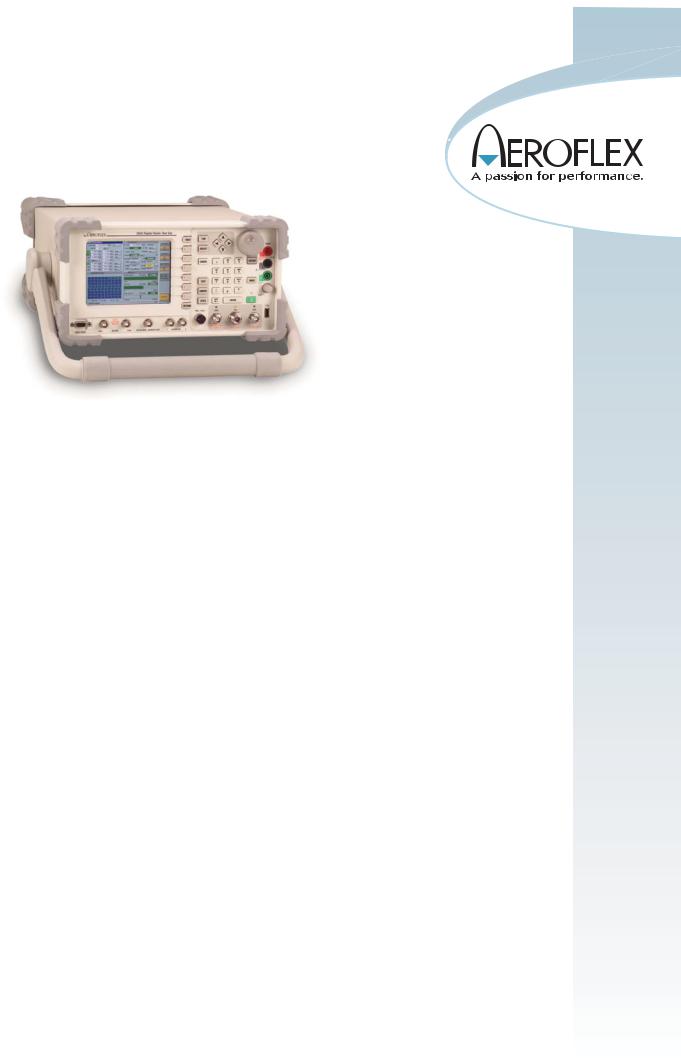
Wireless
3920 Series AnalogandDigitalRadioTestPlatform
Featuring Advanced Automatic Test and Alignment operation for the latest digital radios
|
Now with P25 Phase II! |
|
The 3920 is the latest radio test solution from |
The 3920 also includes many optional features including: |
|
Aeroflex for engineering, production and field |
• 2.7 GHz frequency range extension |
|
service applications. The instrument provides a |
||
• Harmonics and spurious measurements |
||
comprehensive range of general purpose analog |
||
measurement facilities as well as advanced digital |
• Tracking generator |
|
test options. The 3920 includes many standard |
||
• Audio spectrum analyzer and audio tracking generator (used for |
||
features as well as a host of optional test capabilities |
||
and digital personalities. |
analog simulcast alignment) |
|
|
||
The 3920 standard features include: |
• IQ generator for use with IQCreator® |
|
|
||
• 1 GHz frequency range |
• P25 conventional operation with advanced parametric/protocol |
|
analysis |
||
• High performance FM/AM/SSB analog duplex |
||
• P25 trunking operation |
||
test capabilities |
||
|
||
• Sensitive receiver with built-in pre-amp for off |
• LSM generate and receive analysis |
|
|
||
air measurements |
• P25 Phase II TDMA physical layer transmitter and receiver |
|
• Color coded pass/fail results |
testing |
|
|
||
• -140 dBm (typical) DANL spectrum analyzer |
• Off Air Monitor for P25 message logging – protocol analysis tool |
|
|
||
with 8 markers |
• P25 AES encryption |
|
• Dual-Channel oscilloscope to 4 MHz |
• SmartZoneTM and SMARTNETTM trunking |
|
• Full audio analysis for AF level, frequency, |
• DMR (MOTOTRBOTM) mobile and repeater tests |
|
SINAD and distortion measurements |
• TETRA mobile, base station and DMO tests |
|
• Three high accuracy audio modulators/function |
||
• HPD (High Performance Data) base and mobile simulation |
||
generators |
||
• Three high accuracy audio baseband generators |
• NXDNTM, dPMR and ARIB STD T-98 |
|
• Tone encode and decode functionality including |
Automatic test and alignment options include: |
|
|
||
DTMF, DCS, tone remote, 2-tone sequential, |
• Motorola ASTRO, ASTRO 25 and APX Series radios |
|
and 5/6-tone |
• EF Johnson ES Series radios |
|
|
• GPIB, Ethernet, USB and RS-232 interfaces
• BK DPHX5102X Series radios
• HP/Agilent 8920B remote emulation
• TIA/EIA-603 FM land mobile radio test software
• MOTOTRBO radios
• Technisonic Type 1 and Type 2 radios
• Kenwood P25 TK-5X10G Series radios
For the very latest specifications visit www.aeroflex.com
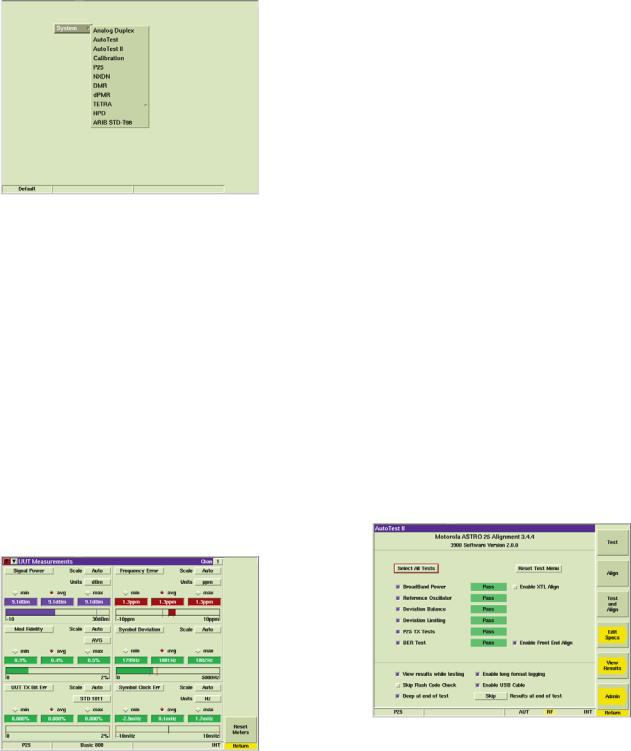
The one test set for all your narrowbanding test needs!
With the largest selection of digital radio options of any radio test set, the 3920 will meet all of your narrowbanding test needs, both now and in the future. The software defined digital architecture of the 3920 provides for future technology enhancements as new digital technology becomes available. You can easily perform software updates in the field, making additions of new software features and options as simple as plugging in a USB flash memory drive.
Menu of Radio Test Systems in the 3920
Ease of Use
Combining the power of an onboard PC with a 30 GB hard-drive and Linux OS, the 3920 can support USB mouse and keyboard interface for very easy operation as well as almost unlimited save/recall setups, saving time and effort. Multiple methods of controlling the 3920 include the front panel keys, using a mouse and keyboard, or through a VNC application on your PC, touch-screen tablet or mobile phone.
Ease of Test
To make you more productive, the 3920 is not only simple to use but has features that makes testing a radio quick and repeatable. The 3920 features easy-to-read meters with Pass/Fail color coding for instant Go/NoGo testing. With these easy-to-configure meters, you can set up unique Pass/Fail parameters for each radio type that you are testing. When used with the save/recall locations, this allows for instant recall of the test parameters, so semi-technical or non-technical individuals can simply key the radio and test. The meters will display "Green" for good, "Red" for high and "Blue" for low. A quick glance and the operator will know that the radio is within established test parameters.
P25 UUT Measurements Tile Maximized, Showing Green, Red and
Blue Indications
High Performance
Measurement speed is directly related to processing power and internal communications. The 3920 digital architecture utilizes a mixture of powerful digital signal processors and programmable logic. Coupled to the use of a compact PCI backplane capable of delivering peak rates of >100 MB, this ensures that the instrument has the power to acquire, synchronize and process data, producing measurement results to the user with the minimum of delay.
Accurate Testing
Time Base: With a 0.01 ppm OCXO frequency standard, the 3920 provides ultra-reliable RF frequency measurements. For even more stability, the 3920 provides an external frequency reference input.
Generator: Level accuracy is important in determining today's receiver performance in design, manufacturing and field service environments. With a 1 dB (0.6 dB typical) level accuracy on the RF output ports, the 3920 provides consistent results in testing receiver parameters.
Receiver: For sensitive measurement, e.g. off-air analysis, a low power input is provided via the antenna input port. This low level input gives the user the ability to measure an off the air signal as low as -100 dBm or -115 dBm with the internal pre-amp selected. Direct input of signal power of up to 125 W is supported, making the 3920 compatible with virtually all practical requirements for mobile terminal and base station test.
Audio: With high accuracy audio generators from 1 mV to 8 V rms, the 3920 provides level accuracy to ±1% of the setting. The audio generator frequency ranges from 20 Hz to 40 kHz and 0.1 Hz resolution provides solid audio performance for audio testing. The AF Counter features full range from 20 Hz to 20 kHz.
Automatic Testing
The Auto-Test II environment provides you with the capability to turn the 3920 into a stand alone ATE test environment. With the built-in PC running your test script, or one of our available automatic test and alignment applications, the 3920 can be conformed to your exact testing needs. Available with the Auto-Test II option for the 3920 are a selection of applications covering many of the latest digital radios. With these applications, you can automatically test and align the transmitter/receiver of a radio in as little as 5 minutes.
Motorola ASTRO 25 Radio Alignment
More automatic test and alignment options are being added all the time. For the latest selection of scripts for the 3920, go to www.aeroflex.com/3920 and click on the 3920 Radio Test Set Scripts link in the Product Directory.
2
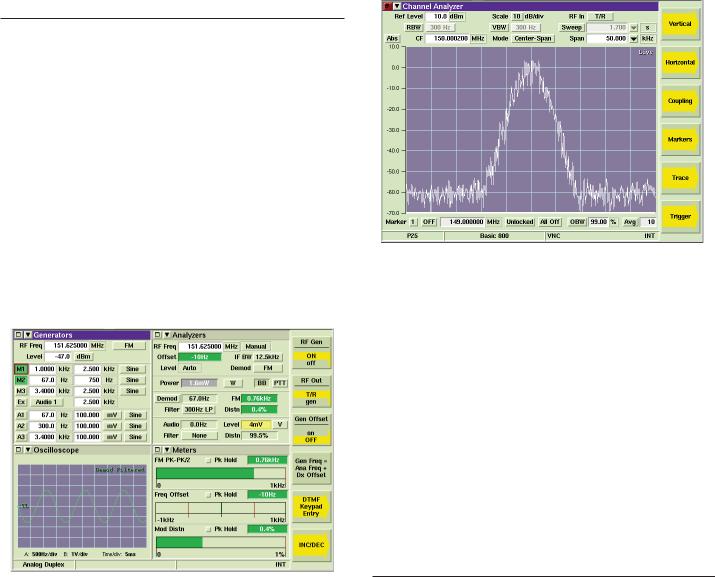
3920 STANDARD FEATURES
FM/AM/SSB Analog Duplex operation: The 3920 features advanced RF testing capabilities for FM/AM/SSB radio transmitters and receivers. The features for analog duplex testing are:
•1 GHz frequency range for transmitter and receiver (2.7 GHz optional)
•Three Modulation sources
•Three Audio sources
•DTMF encode and decode
•DCS encode and decode
•2-tone sequential, 5/6 tone, and tone remote encode and decode
•Channel analyzer that can simultaneous display the RF spectrum while demodulating received signal
•Meters for measuring RF Power, Modulation, Frequency Offset, Distortion, Audio level, SINAD, SNR, and Hum and Noise
•Dual Channel 4 MHz Oscilloscope
Analog Duplex Screen
Spectrum Analyzer
Digital Multimeter: Now standard for the 3920 is the Digital Multimeter. The Digital Multimeter comes with three new ports on the front panel used for measuring AC/DC volts, AC/DC amps and OHMS.
Remote Control: The 3920 supports remote control via GPIB for automated test system control. A VXI pnp VISA driver allows easy test system integration of the 3920. In addition to a native 3920 command set, the 3920 Series also supports commands for the HP/Agilent 8920B that allows migration from the 8920B to the 3920 extremely easy.
Remote Operation: Use of the 3920 Ethernet connection permits remote operation from anywhere in the world making it possible to download new software or remotely interrogate instrument status. With an internal VNC server, users can install VNC software on their PC or Tablet PC and remotely operate the front panel of the 3920 from virtually anywhere on the planet. All that is needed is the ability to access the unit's IP address.
OPTIONAL TEST CAPABILITIES
Site Monitoring Application (390XOPT051)
Full span spectrum analyzer: View signals from 1 MHz to 1 GHz with the 3920 or to a full 2.7 GHz with the frequency extended option. With a DANL of -140 dBm (300 Hz RBW with pre-amp enabled), the 3920 provides high performance spectrum analysis. This full band analyzer provides plenty of range to view harmonics and other spurious emissions in and out of band.
The 3920 brings impressive new capabilities to site monitoring applications. With option 392XOPT051, the user now has the ability to leave the 3920 on-site while the unit provides automated data logging of the site's effective receiver sensitivity. When connected to a good documented receiver (a "golden" radio), the 3920 will automatically calculate the Effective Receiver Sensitivity (ERS) at a predetermined interval (example: every 10 seconds) over a specified time (example: log ERS for 72 hours). As these measurements are taken, a min/average/max SINAD is displayed, and the data is logged to the 3920's internal hard-drive. Spectral information is also optionally logged with each measurement to help locate and track sources of interference. This gives the system engineer a valuable tool in determining site location performance and system RF boundaries.
IQ Gen Modulation (390XOPT054)
IQCreator is an Aeroflex developed PC based software utility that gives the user the ability to develop their own waveforms to use as the modulation source. Since the waveforms are defined by I and Q, virtually any type of complex digital modulation format can be created. With the IQ Gen Modulation option, once the IQ waveform is created it can easily be uploaded to the 3920 and used as the modulation source in the Analog Duplex System.
For the very latest specifications visit www.aeroflex.com |
3 |
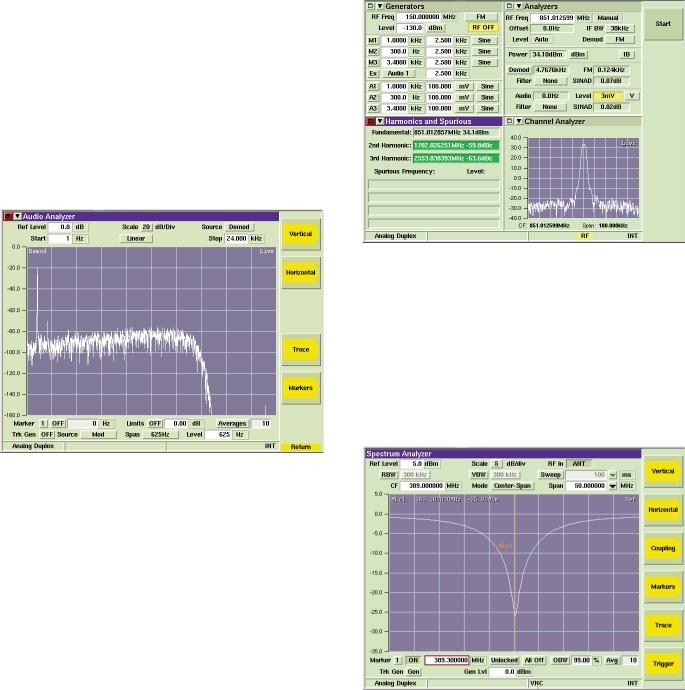
Audio Analyzer (390XOPT055)
With 390XOPT055, the 3920 Series provides audio spectral analysis of the recovered audio signal, either from the audio inputs or from the demodulated RF signal. This feature allows users to view frequency amplitude in relation to other audio frequencies and to isolate problems such as noise in audio circuits. With a frequency range of 1 Hz to 24 kHz, the audio analyzer covers more than the full audio frequency range of mobiles and hand-helds. In addition, there are two markers, plus a peak hold and average function. The user can also capture traces that can be stored and then recalled later for use as a comparison with a live trace. A tracking generator option (390XOPT210) is also available as an add-on to the audio analyzer.
Audio Analyzer
2.7 GHz Frequency Range (392XOPT058)
The 3920 comes standard with a generate and receive frequency range of 10 MHz (100 kHz usable) to 1.05 GHz. This option will extend the range to 2.7 GHz.
Harmonics and Spurious (390XOPT060)
The ability to quickly and accurately measure the harmonics and spurious of the transmitter of a radio is the function of 390XOPT060. The fundamental frequency is automatically detected and measured and then the second and third harmonics are measured and compared. In addition, the spurious signals that are higher than the configured level are identified and displayed. The frequency and level of the fundamental, as well as the harmonics and spurs, are then displayed. This option makes finding the harmonics and spurious transmitter very simple. Simply connect the transmitter of the radio to the 3920, key the radio and press Start.
Harmonics and Spurious
Tracking Generator (390XOPT061)
A full featured spectrum analyzer is available, standard, on all 3920s. Available as an option to the spectrum analyzer, the 3920 tracking generator allows the user to look at the response of a duplexer, filter bank or other RF device on the spectrum analyzer. This option greatly simplifies the often laborious process of checking or changing the tuning of a duplexer. When used with the optional return loss bridge (AC4105), the spectrum analyzer/tracking generator can measure the return loss of an antenna or cable.
Spectrum Analyzer with Tracking Generator
Power Between Markers (390XOPT064)
Also available as an option, the power between markers option provides a measurement of the amount of power between the spectrum analyzer markers. With this feature, the user can set the position of two markers on the spectrum analyzer and then measure the amount of power in the bandwidth selected with those markers. This will enable the user to determine the amount of power in an adjacent channel or in the center channel.
Chinese GUI (390XOPT090)
This option enables the selection of either Chinese or English as the language for the graphical user interface for the Analog Duplex system. When enabled, a selection is added to the utilities screen that allows the user to choose between English or Chinese character display in the audio Analog Duplex system.
4
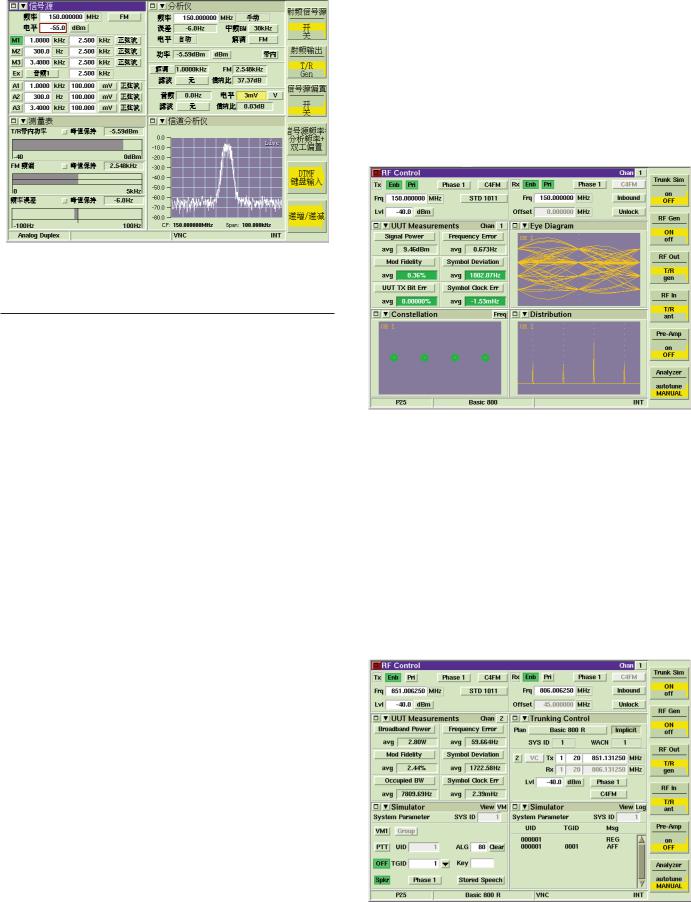
• Transmit full TIA/EIA-102 test patterns (STD1011, CAL, SILENCE, STD511, etc.) as specified by TIA- EIA-102.CAAA-C
• Transmit and receive live audio using the vocoder
• Transmit stored speech patterns
• Decode voice channel header and link control messages
• Encode link control messages
• Perform DES encryption
Illustration of Chinese GUI
OPTIONAL SYSTEM PERSONALITIES
In addition to the Analog Duplex system, the 3920 can support a number of optional test systems or personalities, installed concurrently. Personalities include:
•TETRA digital trunked radio systems for mobile station and base station testing
•TETRA direct mode testing
P25 Conventional
• APCO P25 conventional and trunked radios
•APCO P25 Phase II TDMA
•SmartZone and SMARTNET
•DMR (Digital Mobile Radio)
•NXDN
•HPD (High Performance Data)
•dPMR (digital Private Mobile Radio)
•ARIB STD-T98 (Digital Convenience Radio Equipment For Simplified Service)
P25 CONVENTIONAL OPERATION (390XOPT200)
The 3920 P25 Conventional Option provides test features for testing P25 radios and systems. Featured is the ability to transmit P25 C4FM standard waveforms and analyze P25 received waveforms. The analysis of the received waveforms consists of the ability to perform RF and modulation parametric tests. The vocoder enables the user to perform transmit and receive audio testing. Included in this option is the capability to:
•Measure C4FM modulation fidelity and symbol deviation
•Measure power, frequency error and TX BER
•Measure symbol clock error
•Measure RX BER
•Display eye diagram of C4FM demodulation
•Display constellation plot of C4FM symbols
P25 Trunking Operation VHF/UHF/700/800 MHz (390XOPT201)
To further enhance P25 operation, the addition of the P25 trunking option allows simulation of a P25 control channel in any frequency band. Channel plans may be configured to test virtually any P25 trunked system. A simulator tile logs the messages sent by the radio under test and allows the 3920 to simulate a virtual mobile, configured to talk to the radio under test. This option enables the user to originate a group call to the radio under test or make a group call from the radio under test to the 3920. In addition, the user can have multiple radios register and affiliate with the 3920 and then originate calls from one radio to the other radios.
P25 Trunking Simulation |
|
• Display C4FM symbol deviation distribution plot |
|
For the very latest specifications visit www.aeroflex.com |
5 |

LSM Generate and Receive/Analysis (390XOPT204)
In addition to the standard P25 modulation, also available on the 3920 is the capability to generate and receive Linear Simulcast Modulation (LSM). This option, available as an extension of P25 conventional operation, enables measurements that are specific to LSM. It also adds a graphical analysis of the demodulated LSM signal that is normally only found in vector signal analyzers. Since LSM is a complex type modulation, this plot shows the inphase versus quadrature phase (I versus Q) of the demodulated LSM signal. In addition, this option adds Error Vector Magnitude to the selection of measurements available from the UUT Measurements tile.
LSM Signal Analysis Screen
P25 Control Channel Logger Option (390XOPT206)
This option provides the user a tool to perform advanced protocol analysis on both control channel and voice channel data. With this option the user can log P25 data by streaming the received data in real time from the Ethernet port to a PC. This data is logged in an XML format so that the user can easily view the data using a text editor or use an external program to perform further analysis on the data. This data can be logged at three different levels ranging from the raw data symbols up through decoded data. The data is time-stamped on a frame by frame basis. In addition to being able to log data, the user can also send data to the 3920 to be transmitted, making the 3920 into a completely user defined data modem for P25.
SmartZone and SMARTNET (390XOPT207)
This option provides support for Motorola Astro SmartZone and SMARTNET systems, including support for rebanded channels in the 800 MHz band.
KVL Keyloader Option (390XOPT209)
This option provides an interface to the KVL Keyloader enabling the user to be able to directly enter keys into the 3920 using a KVL-3000+.
Analog Simulcast Option (390XOPT210)
This option is actually an extension to the Audio Analyzer option and acts as a tracking generator for the audio analyzer. This feature is designed primarily for use in characterizing the performance of Motorola Analog Simulcast systems and enables detailed alignment of the 0-100 Hz band. In addition, this option allows for extended characterization of audio circuits from 0-10 kHz.
Explicit Mode Trunking (390XOPT212)
The advanced form of frequency channel assignment known as Explicit Messaging is supported by adding option 390XOPT212 to the P25 Trunking Operation VHF/UHF/700/800 MHz option. The explicit mode of operation assigns the actual channel/frequency over the air by providing the exact TX and RX frequency assignments directly to the radio.
Unit to Unit Call (390XOPT213)
This option adds capability of testing the unit to unit call functionality of a mobile station to the P25 trunking option. The user can either originate a unit to unit call from the mobile station or from the test set.
Adjacent Channel Broadcast Message (390XOPT214)
This option adds the adjacent status broadcast message to the control channel messages transmitted by the 3920. This will enable the user to test the capability of the mobile station to operate correctly in the presence of this message. The purpose of this message is to inform mobile stations of the presence and status of sites adjacent to this particular site.
Secondary Control Channel Broadcast Message (390XOPT215)
This option adds the secondary control channel broadcast message to the control channel messages transmitted by the 3920. This will enable the user to test the capability of the mobile station to operate correctly in the presence of this message. This message is used to inform mobile stations of other control channels or other potential backup control channels at this site.
P25 Phase II Two-Slot TDMA (Time Division Multiple Access) Physical Layer (390XOPT220)
One of the newest features of the 3920 is the capability to test P25 Phase II TDMA operation of both base stations and mobile stations. With this option, the 3920 can measure and analyze the different modulations used for both the outbound and inbound signals used in P25 Phase II. With the modulation for Phase II being completely different from the Phase 1 C4FM modulation; this option is critical for radio technicians, designers, or anyone involved with the roll-out of P25 Phase II systems. Included with this option are the following features:
•H-CPM (inbound modulation) modulation and demodulation
•H-CPM eye diagram, distribution plot, and constellation
•H-DQPSK (outbound modulation) modulation and demodulation
•H-DQPSK eye diagram, distribution plot, and constellation
•Generation of all H-CPM standard patterns
•Generation of all H-DQPSK standard patterns
•UUT measurements for Phase II including modulation fidelity, symbol deviation, symbol clock error, frequency error, power and TX Bit Error
6
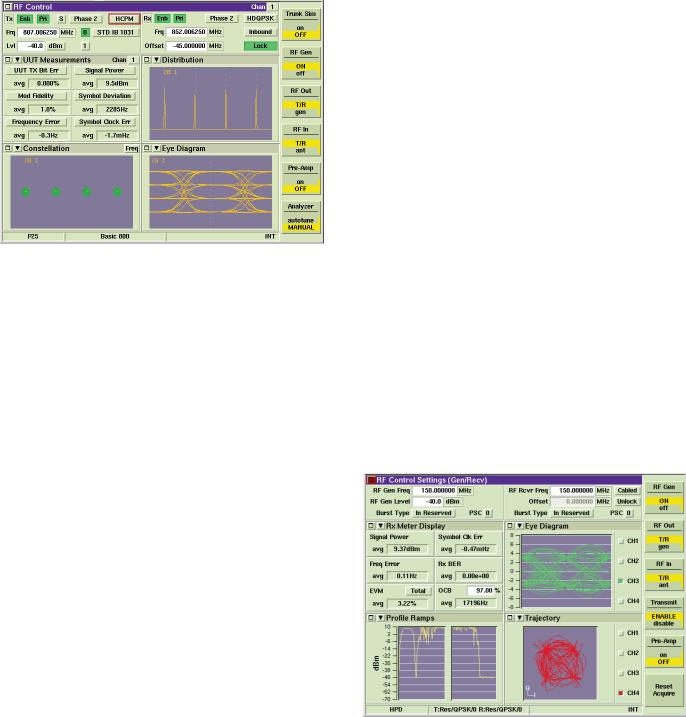
|
MOTOROLA HPD TESTING OPTION (390XOPT300) |
|
|
• Generate/receive HPD signals |
|
|
• Modulation - 64QAM, 16QAM and QPSK (inbound and |
|
|
outbound) |
|
|
• Transmitter parameters including signal power, frequency error, |
|
|
EVM |
|
|
• Symbol clock error, RX BER, burst timing error and occupied |
|
|
bandwidth |
|
|
• I & Q modulation analysis including constellation and trajectory |
|
|
plots of the data symbols, synch and pilot bits |
|
|
• Display of Min/Max and average as specified by the number of |
|
|
bursts |
|
|
• Pass/Fail indication using color code meters |
|
P25 Phase II |
Aeroflex has developed this test mode for Motorola to address the |
|
|
|
|
Off Air Monitor Software for P25 Message Logging - Protocol |
need for testing their high performance packet data operation on both |
|
Analysis Tool (390XOPT230) |
mobiles and base stations in the 700 and 800 MHz bands. HPD |
|
The Aeroflex 3900 Series P25 Off Air Monitor (OAM) is used to |
systems operate within the normal 25 kHz mobile radio bandwidth. |
|
The 3920 HPD options provide users with the ability to test High |
|
|
capture and view APCO P25 messages sent over the air. The OAM |
|
|
Performance Data systems. HPD can be configured for two modes of |
|
|
can receive and demodulate P25 RF signaling, decode P25 messages |
|
|
operation. When configured to operate in BR Mode the test set |
|
|
and log these messages to a file for later viewing. Both trunked |
|
|
simulates base radio operation and is used to test the functionality of |
|
|
(control and traffic) and conventional channels are supported, |
|
|
Motorola HPD Mobile Subscriber Units (MSU). When configured to |
|
|
allowing network engineers to: |
|
|
operate in MSU Mode the test set simulates Mobile Subscriber Unit |
|
|
• Verify compliance to P25 standards |
|
|
operation and is used to test the functionality of Motorola Base |
|
|
|
|
|
• Troubleshoot existing P25 systems |
Repeaters (BR). |
|
|
|
|
• Analyze third party signaling |
|
|
This option is a PC application that, using the data from option |
|
|
390XOPT206, performs an advanced decoded display and log of the |
|
|
XML data streams from multiple P25 channels. This provides the |
|
|
user with the data to perform a complete analysis of all channels of a |
|
|
P25 trunked system. |
|
|
P25 AES Encryption (390XOPT240) |
|
|
With the addition of this option, the 3920 supports P25 encryption |
|
|
formats and manual key entry for systems that employ DES OFB |
|
|
Type III (included in 390XOPT200) or AES encryption |
|
|
(390XOPT240). These options allow decoding of encrypted voice |
|
|
frames to verify encrypted channel performance. Encryption keys |
|
|
may be loaded manually using either the front panel or external |
|
|
keypad or with option 390XOPT209, keys may be loaded with the |
|
|
Project 25 Key Fill Device (KFD) interface protocol. Additionally, keys |
|
|
may be loaded using KVL ASN mode of operation found in KVL-3000 |
Example of HPD Tiles |
|
and older model key loaders from Motorola. |
|
|
X2-TDMA Test Suite (390XOPT219) |
|
|
Available for testing X2-TDMA test systems, this option is available |
|
|
through Motorola only. |
|
|
X2-TDMA Mobile Emulator (390XOPT245) |
|
|
This option enables the testing of X2-TDMA base stations. This |
|
|
option is available through Motorola only. |
|
|
X2-TDMA Advance Test Suite (390XOPT261) |
|
|
This option combines 390XOPT216 and 390XOPT245. |
|
|
For the very latest specifications visit www.aeroflex.com |
7 |
|

Motorola HPD Advanced Analysis Package (390XOPT301)
More advanced features are available with 390XOPT301 including:
•Received Data Stream Logger. Logs the data portion of the HPD signal and displays it in hex.
•RX Time Display. Shows frequency error, power and symbol clock error over time.
•HPD Magnitude/Phase Estimation. Displays magnitude and phase fluctuations of the received signal.
•Eye Diagram and I/Q over time displays
•Power Profile. Shows the power over time and in a burst (TDMA transmission).
•Power Ramps. Shows the power up and power down portion of the TDMA burst.
Motorola HPD Testing Suite (390XOPT302)
This option combines 390XOPT300 and 390XOPT301.
DMR (390XOPT400)
Add advanced testing capability for DMR (Digital Mobile Radio) with 390XOPT400. This option enables the Aeroflex 3920 Series Digital Radio Test Set to test and align a wide range of DMR repeaters and mobile stations. DMR radio technology is a digital radio format offering advanced communications features specified by the ETSI technical standard ETSI TS 102-361-1. Capabilities of the 3920 include:
•Generate and receive DMR modulated signals
•Measure FSK error and magnitude error
•Measure symbol deviation
•Measure symbol clock error
•Measure slot power
•Distribution plot of symbol deviation
•Eye diagram of FSK demodulation
•Power profile of burst and of burst ramp up/ramp down
•Transmit and receive live audio using the vocoder
•Transmit stored speech patterns
•Test duplex or simplex mobiles
•Wake-up burst for testing repeaters
•Synchronize with repeaters
•BER testing
•Encode color code and call ID
•Decode color code, unit ID and call ID
Example of DMR Tiles
DMR XML Channel Logger Option (390XOPT402)
With this option, the user can now capture and log to a file (on a PC connected to the 3920 through a LAN) the raw data that is transmitted by a mobile station or repeater. The data is formatted using XML, so that it can be decoded with an external program (developed by the user) or viewed with a text editor. This is perfect for the engineer doing development work or the test engineer in the field that needs to capture the data being transmitted by a repeater or subscriber unit. The data is captured by connecting a PC to the 3920 through an Ethernet crossover cable. Using the PC application, (available at www.aeroflex.com/3920) “DMR XML channel logger for 3920”, the user can both log DMR XML data and send XML files that can control the data being transmitted by the 3920.
dPMR (390XOPT420)
dPMR is an ETSI standard specified in ETSI TS 102 658. This option adds advanced testing capabilities that conform to the requirements of this ETSI standard. The transmitter tests include power, frequency error, FSK error, symbol deviation and symbol clock error. This option also provides several graphical screens that provide more insight into the accuracy of the dPMR modulation.
NXDN (390XOPT440)
Add advanced testing capability for NXDN with 390XOPT440. This option enables the Aeroflex 3920 Series Digital Radio Test Set to perform a variety of Transmitter and Receiver tests on any NXDN radio. Transmitter measurements include:
•Signal power
•Frequency error
•FSK error
•Symbol deviation
•TX BER
•Symbol clock error
The system supports both 4800 and 9600 baud systems. The 3920 can also analyze the modulation as an eye diagram, symbol distribution plot and a symbol constellation plot. A power over time graph can be used to diagnose power-related issues.
8
